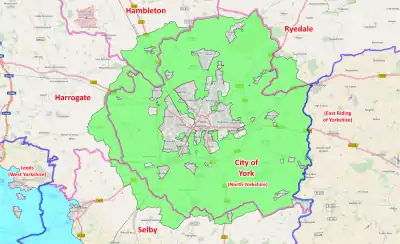York Green Belt
The City of York Green Belt is a green belt environmental and planning policy that regulates the rural space within the Yorkshire and the Humber region of England. It is contained wholly within the county of North Yorkshire. The core function of the belt is to more rigorously manage development around York and surrounding areas, preserving its setting and historic character, discouraging urban sprawl, and convergence of outer villages into the built up areas of the city.[1] It is managed by local planning authorities on guidance from central government.

Purpose
There are five stated local aims for the green belt:[2]
- Maintain the historic setting and character of York;
- Keep the urban sprawl of York in check;
- Preserve the surrounding countryside from further development;
- Stop nearby settlements converging towards each other;
- Encourage urban regeneration, by promoting the recycling of brownfield or other urban land.
Geography
Formally created in 1980 after decades of being an interim local policy since the 1950s, the local development plan defines the green belt outer edge as being 'about 6 miles from York'.[2] Land area taken up by the belt is 25,553 hectares (255.53 km2; 98.66 sq mi) hectares (0.2% of the total land area of England (2010).[3] The belt nearly covers all of the city district, but avoids the main built-up area and larger surrounding villages. It extends into the surrounding North Yorkshire districts of Hambleton, Harrogate, Ryedale, and Selby. East Riding of Yorkshire borders York but does not contain any green belt.
The rural areas and smaller villages of the district are "washed over" wholly with green belt, meaning there is limited development scope in these areas:[2]Acaster, Malbis, Askham Bryan, Askham Richard, Deighton, Heslington, Hessay, Holtby, Hopgrove, Knapton, Murton, Naburn and Rufforth. The South and West Yorkshire Green Belt lies a few miles to the south west. Due to the York city belt lying across several adjacent districts, responsibility and co-ordination lies with the city and aforementioned local district councils whose land covers the belt, as these are the local planning government bodies.
See also
References
- Fawcett, Tony. "Green Belts: A greener future - Campaign to Protect Rural England".
- Council, City of York. "City of York Council download - The Development Control Local Plan (2005) and proposals maps - Planning and building - Planning policy". www.york.gov.uk.
- "Green Belts in England: Key facts - A series of factsheets on England's 14 Green Belts".